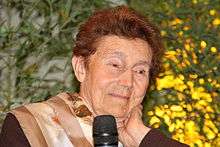Hélène Langevin-Joliot
Hélène Langevin-Joliot (born 19 September 1927) is a French nuclear physicist. She was educated at the IN2P3 (English: Institute of Nuclear Physics and Particle Physics) at Orsay, a laboratory which was set up by her parents Irène Joliot-Curie and Frédéric Joliot-Curie. She is a member of the French government's advisory committee.[2] Currently, she is a professor of nuclear physics at the Institute of Nuclear Physics at the University of Paris and a director of research at the CNRS. She is also known for her work in actively encouraging women to pursue careers in scientific fields.[3][4] She is chairperson of the panel that awards the Marie Curie Excellence award, a prize given to outstanding European researchers.[5] She was president of the French Rationalist Union from 2004 to 2012.[6]
Hélène Langevin-Joliot | |
|---|---|
 Hélène Langevin-Joliot (2012) | |
| Born | 19 September 1927 |
| Nationality | French |
| Citizenship | France |
| Scientific career | |
| Fields | Physics |
| Institutions | CNRS |
| Notes | |
Parents: Irène Joliot-Curie and Frédéric Joliot
Grandparents: Marie and Pierre Curie Great Uncle: Józef Skłodowski Great Aunts: Zofia Skłodowska, Bronisława Skłodowska, and Helena Skłodowska.[1] | |
Family
Langevin-Joliot comes from a family of well-known scientists.
- Her maternal grandparents were Marie and Pierre Curie, famous for their study of radioactivity, for which they won a Nobel Prize in physics with Henri Becquerel in 1903. Marie Curie is the only person to win Nobel Prizes in two different sciences, her second was awarded in chemistry in (1911) for her discoveries of radium and polonium.
- Her parents, Jean Frédéric Joliot-Curie (born Jean Frédéric Joliot) (who was mentored by Marie) and Irène Joliot-Curie (born Irène Curie), won a Nobel Prize for chemistry in 1935 for their discovery of artificial radioactivity.
- Her brother Pierre Joliot is a noted biophysicist who has made contributions to the study of photosynthesis.
In response to her family's legacy, Langevin-Joliot regularly grants interviews and gives talks about their history.[4][7] Her knowledge of her family's history led to her writing the introduction to Radiation and Modern Life: Fulfilling Marie Curie's Dream, including a brief history of the Curies.[8]
Her husband, Michel Langevin, was grandson of the famous physicist Paul Langevin (who had an affair with the widowed Marie Curie, Hélène's grandmother, in 1910) and was also a nuclear physicist at the institute; her son, Yves (b. 1951), is an astrophysicist.[7][9]
References
- "Marie Curie – Polish Girlhood (1867–1891) Part 1". American Institute of Physics. Retrieved 7 November 2011.
- "Rencontre avec Hélène Langevin-Joliot" (in French). canslup.unilim.fr. Retrieved 2010-02-03. Google translation
- "Madam {sic} Curie's Legacy". best.me.berkely.edu. Archived from the original on 2006-09-05. Retrieved 2007-01-17.
- "An Interview with Hélène Langevin-Joliot, the Granddaughter of Pierre and Marie Curie". Archived from the original on 2007-09-27. Retrieved 2007-04-06.
- "First EU Marie Curie Awards in recognition of world-class achievements in European research". Archived from the original on 2007-02-24. Retrieved 2007-04-06.
- "Union rationaliste – Qui sommes-nous ?" (in French). union-rationaliste.org. Retrieved 2007-04-12.
- "Marie & Pierre Curie's granddaughter, Hélène Langevin-Joliot, visits the United States". Eurekalert.org. Retrieved 2007-01-17.
- Landsberger, S. (2006). "Radiation and modern life Fulfilling Marie Curie's dream". Journal of Clinical Investigation. 116 (2): 286. doi:10.1172/JCI27773. PMC 1359067.
- "Family Records". Archived from the original on 2007-09-27. Retrieved 2007-01-24.